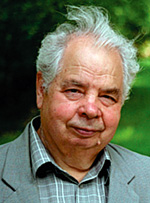Oleg Aleksandrovich Lavrentyev
DOI: 10.1063/PT.3.1306
Oleg Aleksandrovich Lavrentyev, regarded as a founding father of Soviet fusion research, died of cardiac arrest on 10 February 2011 in Kharkov, Ukraine.
Lavrentyev was born on 7 July 1926 in Pskov, Soviet Union. He became interested in nuclear physics in his youth after reading a book about it, but his quest to learn more was put on hold after the outbreak of World War II. In 1944, with only an eighth-grade education, he crossed the front line and volunteered in the Soviet army as an artilleryman. After the war he continued service in the army as a signalman on Sakhalin Island until July 1950. In the army’s library on the island, Lavrentyev read all the books he could find on math, physics, and chemistry. He learned about the atomic bomb and attempts to create a hydrogen one.
Lavrentyev sent a letter to the Kremlin saying, “I know the secret of the hydrogen bomb.” An officer sent by the Kremlin to interrogate Lavrentyev gave him two weeks to put his ideas in writing. In two weeks during July 1950, he secretly wrote the report, in which he confidently declared that a hydrogen bomb could be made with lithium-6 deuteride and initiated by a huge pulse of neutrons from a nuclear fission bomb to create tritium and facilitate deuterium–tritium thermonuclear fusion reactions.
In the report, Lavrentyev also advocated developing, for peaceful applications, a nuclear fusion reactor in which spherical electrostatic grids would accelerate and confine plasma. The proposal, made independently before others published their work on the topic, initiated the Soviet program on controlled thermonuclear fusion research. Lavrentyev’s report, which Andrei Sakharov reviewed positively, inspired Sakharov and Igor Tamm to consider using magnetic fields for fusion reactors.
Lavrentyev enrolled in Moscow State University in August 1950. During an accelerated program of study, he proposed an “electromagnetic trap” that would confine plasma by electrostatic plugging of magnetic cusps.
Several months elapsed before government officials finally contacted Lavrentyev about the report. The nuclear weapons program, overseen by secret police chief Lavrenti Beria, provided him with an apartment and a tutor. But in 1953, before Lavrentyev graduated, Joseph Stalin died, and Beria was executed. People wrongly associated Lavrentyev with Beria, which led to Lavrentyev’s being ostracized and not receiving a promised job at the nuclear weapons development laboratory (now the Kurchatov Institute).
In April 1956 Lavrentyev was hired by the Kharkov Physical-Technical Institute (now the Kharkov Institute of Physics and Technology) in Ukraine, where he worked his entire career. In 1966, under the direction of Boris Safronov, he completed his Kandidat dissertation—on electromagnetic traps—at the institute.
Lavrentyev built small electromagnetic traps, but he was unable to construct a bigger machine after his supervisor, Anatoly Kalmykov, died and funding was cut. Although he never received adequate financial support, Lavrentyev was still able to pursue his research on a low budget.
Lavrentyev developed the theory of plasma confinement and heating in electromagnetic traps; it included the lifetime of ions diffusing in velocity space over the potential barrier and the reduction of the potential barrier by electron space charge in the gaps between the anodes. He analyzed the collisionless heating of ions during electron-beam injection and determined the electron loss rates by diffusion across and along the magnetic field and in velocity space over the electrostatic potential barrier of the cathodes. In his Jupiter 2M experiment, Lavrentyev and his group measured the predicted potential well and demonstrated that electron cross-field diffusional losses were nearly classical.
In 2004 Lavrentyev was awarded a doctor of sciences degree by the Kharkov National University for his thesis “Electrostatic and electromagnetic traps of high-temperature plasma.” In his later years, he designed a 4-GW “Elemag” thermonuclear reactor, a powerful neutron source for materials testing. He devised a mechanism to directly convert electron thermal energy into electricity and demonstrated it at low currents. Five students earned their Kandidat degrees under his leadership. He wrote or cowrote more than 100 scientific articles and had 30 inventions. He was named the 2003 Honored Worker in Science and Technology of the Ukraine and was awarded the 2004 K. D. Sinelnikov Prize of the Ukrainian Academy of Sciences for excellence in plasma physics.
Lavrentyev will be remembered for his innovative vision, patient persistence, gentle manner, and kindness, and for inspiring the field of nuclear fusion research in the Soviet Union.

Oleg Aleksandrovich Lavrentyev

More about the Authors
Thomas J. Dolan. University of Illinois at Urbana-Champaign.
Vladimir S. Voitsenya. Kharkov Institute of Physics and Technology Kharkov, Ukraine.




